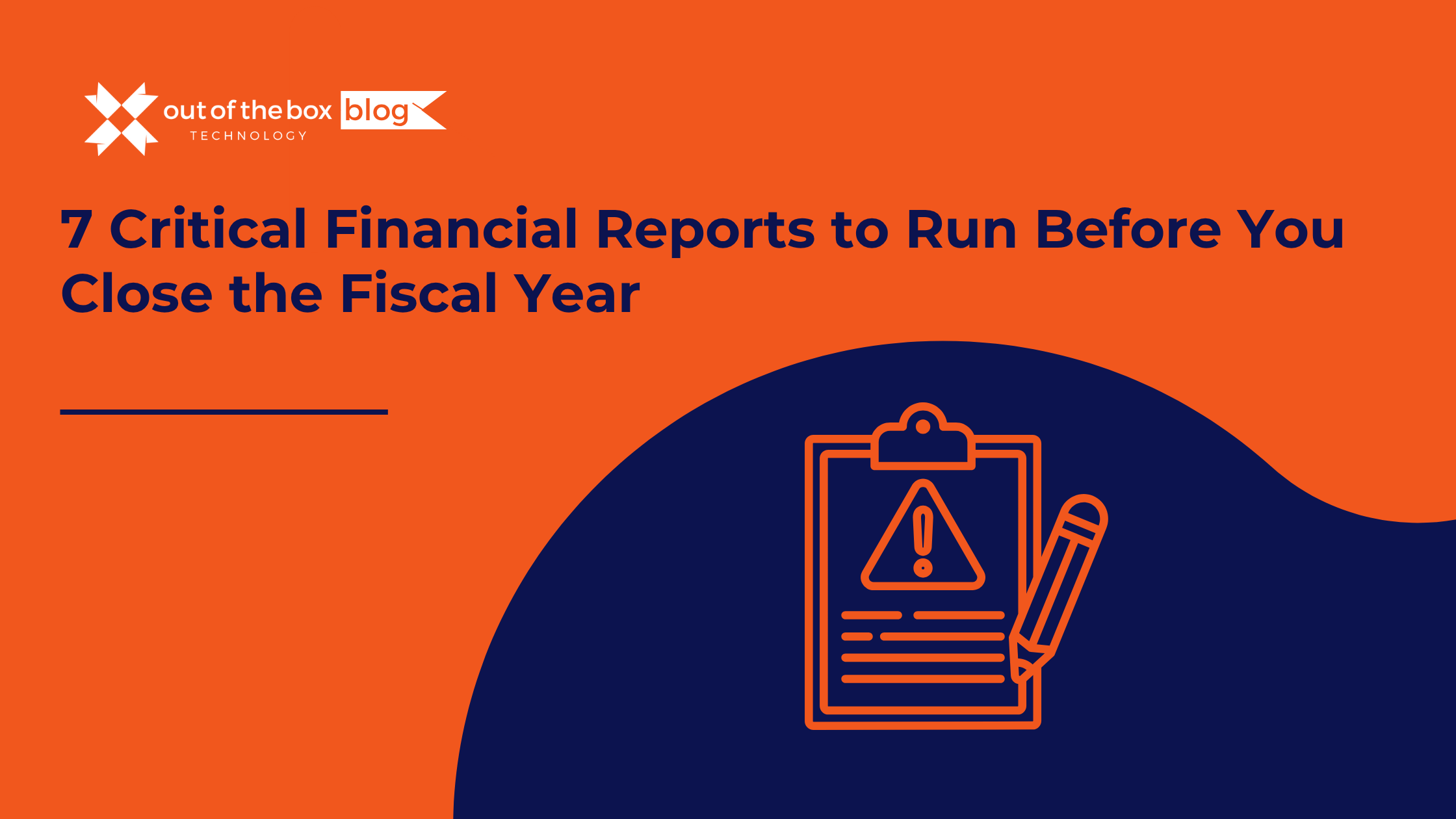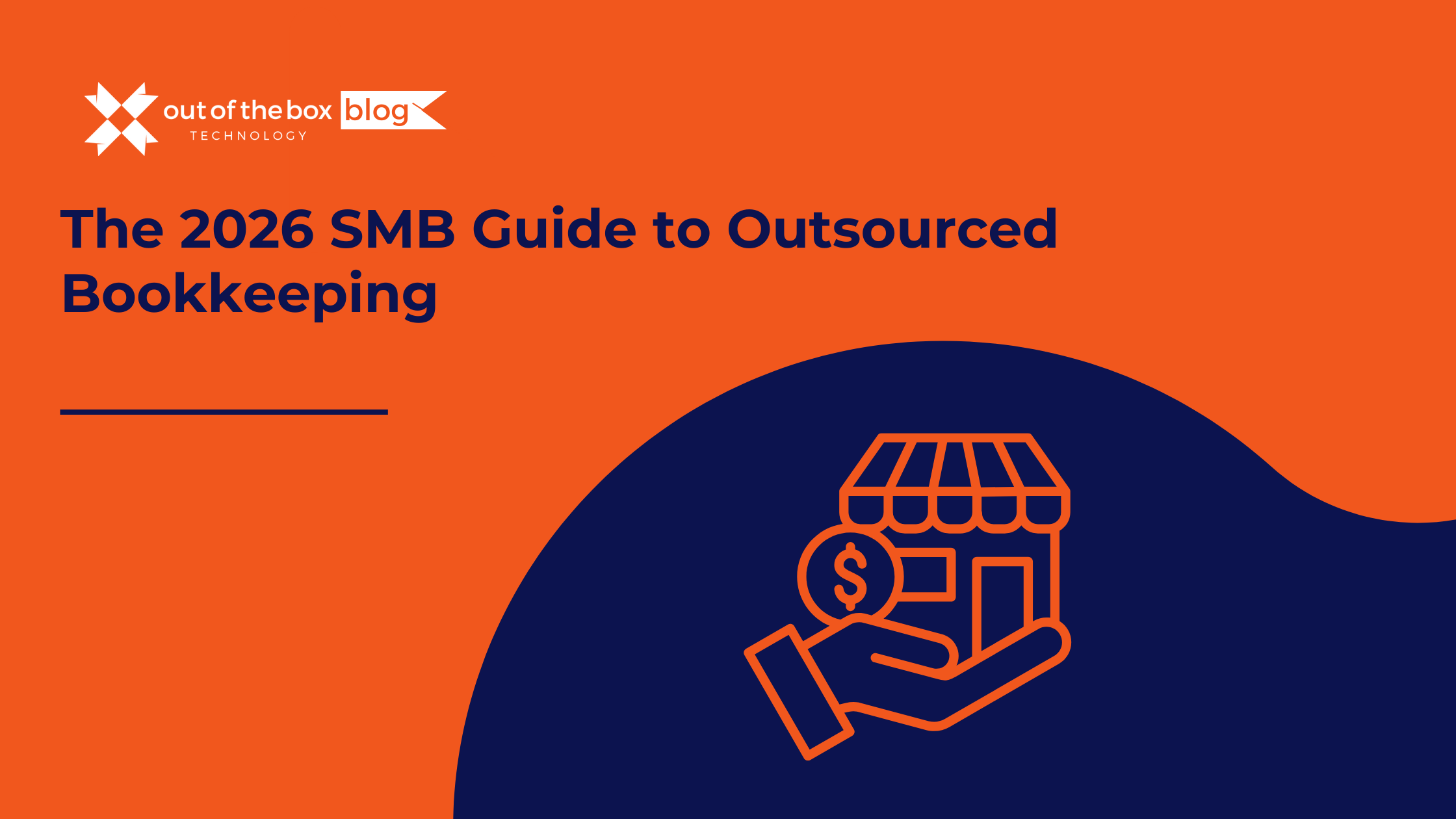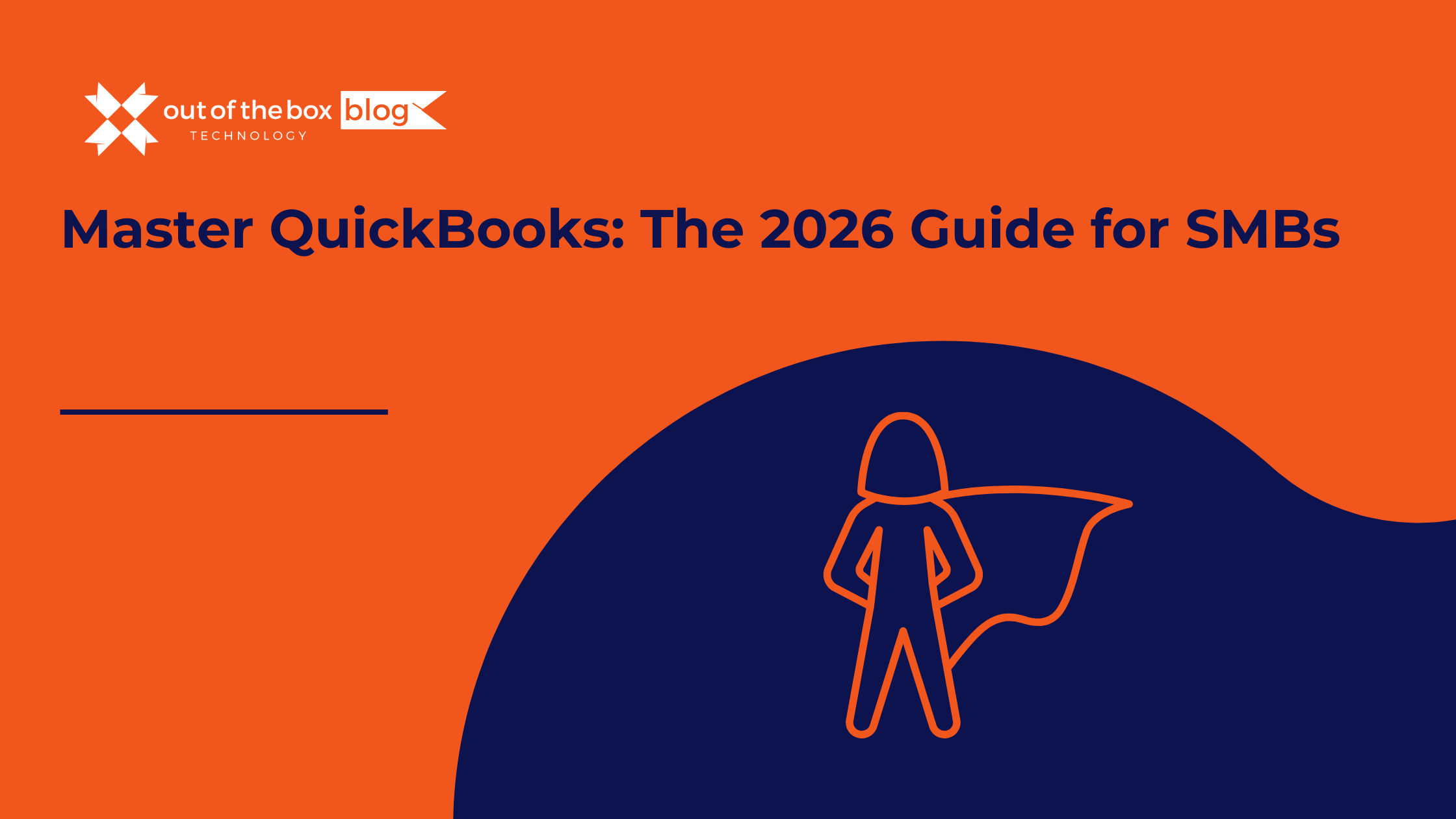You’re managing holiday sales, dealing with team vacations, and trying to hit your final targets. Then, sometime in January, the scramble begins: the frantic hunt for receipts and the panicked call to your tax preparer, all in an effort to “get the books done.”
Most business owners see year-end financial reporting as a chore—a backward-glance at 12-month-old data just to satisfy the IRS.
At Out of the Box Technology, we’ve guided thousands of businesses through this process, and we can tell you with certainty: this is a massive, missed opportunity.
Viewing your year-end reports as just “tax documents” is like a football team watching game film after the season is over. It’s too late. The real professionals—the high-growth companies—review the film before the next play.
Your year-end financial reports aren’t an epitaph for the last year. They are the strategic blueprint for the next one.
Running and, more importantly, understanding these reports before you officially close the fiscal year is the most critical strategic exercise you can perform. It’s your one chance to catch costly errors, identify cash-draining trends, and build a data-driven plan for a more profitable new year.
This isn’t a “nice to do.” It’s a “must-do.” Here are the 7 critical financial reports you need to run and review before you close the books.
1. The Profit & Loss (P&L) Statement
Also Known As: The Income Statement, The “Scoreboard”
What It Is
The P&L is the most straightforward report. It answers one simple question: “Did we make money?” It does this by summarizing your total Revenue (money in) and subtracting your total Expenses (money out) over a specific period—in this case, the full fiscal year (January 1 – December 31).
Revenue - Expenses = Net Profit (or Loss)
Why It’s Critical Before Year-End
This is your company’s annual report card. Before you “file it away,” you need to review it for accuracy. A miscategorized expense could cost you thousands in overpaid taxes. An overlooked revenue stream could be a missed opportunity. Your tax preparer will assume the categories are correct; it’s your job to confirm they are.
What to Look For (The Actionable Part)
Don’t just look at the bottom-line number. Scan every single line item and ask “why?”
- Look for Outliers: Did your “Repairs & Maintenance” cost jump 300% from last year? Why? Was it a one-time emergency (like a new HVAC system) that might have been a Fixed Asset instead? Or is it a sign of aging equipment that needs a capital plan for next year?
- Check for “Junk Drawers”: Do you have a large balance in “Miscellaneous,” “Ask My Accountant,” or “Uncategorized Expenses”? These are giant red flags for your CPA and prime targets in an audit. Every dollar in these accounts needs to be re-categorized to its actual home (e.g., “Software,” “Meals,” “Office Supplies”) before you close.
- Analyze Gross Profit: Look at your Cost of Goods Sold (COGS). If your revenue grew by 10% but your COGS grew by 30%, your profit margins are shrinking. This is an urgent problem that a P&L review makes impossible to ignore.
- Example: A franchise client of ours reviewed their P&L to find “Dues & Subscriptions” had ballooned. They discovered they were still paying for software licenses for three employees who had left the company. That simple 10-minute review saved them over $2,000 for the next year.
2. The Balance Sheet
Also Known As: The Statement of Financial Position, The “Foundation”
What It Is
If the P&L shows your performance over time, the Balance Sheet shows your financial health at a single moment in time (e.g., as of 11:59 PM on December 31st).
It’s built on the fundamental accounting equation: Assets = Liabilities + Equity
- Assets: What you own (cash, equipment, inventory, A/R).
- Liabilities: What you owe (credit card debt, loans, A/P).
- Equity: The difference between the two (your net worth).
Why It’s Critical Before Year-End
This is the most overlooked and most important report. Your Balance Sheet proves if your P&L is even correct. It’s the source of truth. A clean Balance Sheet is the bedrock of a healthy company and is the first thing any bank or investor will analyze.
What to Look For (The Actionable Part)
Your goal is to verify that every number is real.
- Check Your Bank Balances: Does the “Cash in Bank” line item exactly match the balances on your December 31st bank statements (after reconciliation)? If not, your books are wrong. Period.
- Review Your Loan Balances: Does the “Long-Term Liability” for your truck loan match the year-end statement from your lender? If you’ve just been booking the entire loan payment as an “auto expense” on your P&L, you have a major error. You must split the payment between Principal (which reduces the liability on the Balance Sheet) and Interest (which is the expense on the P&L).
- Look for “Zombie” Assets: Do you have “Inventory” from 2019 still on your books? If you can’t sell it, it’s not an asset. It needs to be written off.
- Analyze Your Current Ratio: A key metric banks use. Take your Total Current Assets and divide by your Total Current Liabilities. A ratio of 2:1 or higher is generally considered healthy. A ratio below 1:1 suggests you may have trouble paying your short-term bills—a critical cash flow warning.
3. The Statement of Cash Flows
Also Known As: The “Reality Check”
What It Is
This report is the “truth-teller.” Your P&L can say you had a $100,000 profit, but your bank account can be empty. How? The Statement of Cash Flows explains.
It bridges the gap between your P&L and your Balance Sheet by showing exactly where cash came from and exactly where it went. It’s broken into three sections:
- Operating Activities: Cash from your day-to-day business (sales, paying suppliers, etc.).
- Investing Activities: Cash from buying or selling long-term assets (new equipment, a building).
- Financing Activities: Cash from loans, owner investments, or owner draws.
Why It’s Critical Before Year-End
This is the report that stops all arguments. A U.S. Bank study found that 82% of small business failures are due to poor cash flow management. Profit is an opinion; cash is a fact. This report shows you the facts.
What to Look For (The Actionable Part)
- Profit vs. Cash: Look at the very top (Net Income) and the very bottom (Net Change in Cash). If you had a $100,000 profit but your cash decreased by $50,000, this report shows you why.
- The “Why” of the Cash Gap:
- Did A/R grow? (You “made” sales but your customers haven’t paid you yet).
- Did you pay down debt? (A “Financing” activity that doesn’t show on the P&L).
- Did you buy a new truck? (An “Investing” activity).
- Did you take too much in owner’s draws? (A common, silent business killer).
- Example: A home services client was constantly stressed. His P&L showed a $250,000 profit, but he was always juggling payroll. His Statement of Cash Flows showed the problem: he had spent $200,000 on new vehicles (Investing) and his Accounts Receivable (Operating) had grown by $100,000. He wasn’t losing money; his cash was just trapped in trucks and unpaid invoices. This report gave him the data to focus on collections and secure a line of credit.
4. Accounts Receivable (A/R) Aging Summary
Also Known As: The “Who Owes You Money” Report
What It Is
A simple, powerful report that lists all your outstanding invoices, grouped by how late they are (e.g., Current, 1-30 days, 31-60 days, 61-90 days, 91+ days).
Why It’s Critical Before Year-End
This isn’t just an accounting report; it’s an action plan. Every dollar sitting in the “91+ days” column is a high-risk, interest-free loan you are giving your customer. It’s a direct threat to your cash flow. Before you close the year, you must identify what’s realistically collectible.
What to Look For (The Actionable Part)
- The 91+ Column: Look at this column first. Be brutally honest. If “Smith Co.” hasn’t paid in 6 months and won’t return your calls, that $10,000 invoice is not an asset. It’s a loss. Talk to your accountant about formally writing off bad debt, which can often be claimed as a tax deduction.
- Concentration Risk: Is one client responsible for 80% of your A/R? That’s a huge risk to your business. This report gives you the data to diversify your client base in the new year.
- Collection Process: Are all your clients sitting in the “31-60 days” column? Your terms might be “Net 30,” but your reality is “Net 45.” Your collection process is broken. This report is the proof you need to fix it (e.g., automate reminders, take deposits, offer early-pay discounts).
5. Accounts Payable (A/P) Aging Summary
Also Known As: The “Who You Owe Money” Report
What It Is
The mirror image of A/R. This report lists all the bills you owe to your vendors, grouped by how late they are.
Why It’s Critical Before Year-End
This ensures you capture all your expenses for the year, which is crucial for an accurate tax filing. This is the cornerstone of accrual-basis accounting. If you get a bill in January for a service you received in December, it is a December expense. Failing to record it means you are overstating your 2024 profit and will overpay your taxes.
What to Look For (The Actionable Part)
- Missing Bills: Go through your report. Now, think: did you get a bill from your lawyer in December? Your gas utility? Your biggest supplier? If you don’t see them on the list, you must enter them with a 2024 date to get the deduction.
- Vendor Relationships: Are you late paying your most important supplier? This report can be a warning sign that you’re damaging a critical relationship.
- Cash Flow Planning: Use this report to plan your cash outlays for the first two weeks of January. No surprises.
6. Expenses by Vendor Summary
Also Known As: The “1099 Prep” Report
What It Is
A simple list that totals every dollar you spent, summarized by who you paid.
Why It’s Critical Before Year-End
This report is your single best tool for 1099 compliance. You are legally required to send a 1099-NEC form to any unincorporated contractor (like an individual, LLC, or partnership) to whom you paid $600 or more for services during the year. The deadline is January 31st, and the penalties for failing to file are steep.
What to Look For (The Actionable Part)
- The $600+ List: Run this report and highlight every vendor you paid more than $600.
- The W-9 Check: Go down that highlighted list and ask one question: “Do I have a W-9 form on file for them?”
- If yes, you’re in good shape.
- If no, you need to contact them immediately to get one. You cannot file a 1099 without their Tax ID Number.
- Clean-Up: You’ll also find errors. “Oh, I paid my consultant ‘Jane Smith’ twice—once under her name and once under ‘Jane’s Design, LLC.’ ” This report lets you merge those vendors so your 1099 total is correct.
7. Profit & Loss Comparison (vs. Last Year)
Also Known As: The “Strategic” Report
What It Is
This is the P&L on steroids. It shows your 2024 P&L side-by-side with your 2023 P&L, and it typically includes two extra columns:
- $ Change: The raw dollar difference.
- % Change: The percentage difference.
Why It’s Critical Before Year-End
This is the report that turns you from a “business owner” into a “CEO.” It provides context and reveals trends. It moves you beyond “what” happened and into “why” it happened. This is the exact report a Fractional Controller uses to guide strategic decisions.
What to Look For (The Actionable Part)
Ignore the small stuff and look for the big swings.
- Margin Erosion: Your Revenue grew by 15% (Great!). But your COGS grew by 30% (Terrible!). This means your Gross Profit Margin is shrinking. You are working harder for less money on every sale. This report makes the problem plain as day. You must either raise prices or cut costs in the new year.
- Expense Creep: Your revenue was flat, but your “Travel & Meals” went up 50%, “Software” went up 40%, and “Office Supplies” went up 30%. This is “death by a thousand cuts.” This report gives you a hit list for your 2025 budget.
- Smart Investments: “Wow, our ‘Marketing’ budget went up 100%, but our ‘Revenue’ went up 200%. That investment worked. Let’s double down.”
- Example: A manufacturing client used this report to spot that their “Raw Materials” cost had increased by 22% while revenue from that product line only grew 5%. It turned out their supplier had raised prices twice without them noticing. The report gave them the data to renegotiate their contract, saving them over $50,000 in the coming year.
From Reports to Reality: When Data Isn’t Enough
Running these 7 reports will put you in the top 10% of business owners. But here’s the honest truth: the reports themselves have no value.
They are just numbers on a page.
Their value comes from analysis. Their power comes from action.
If you’ve run these reports and feel more overwhelmed than enlightened, you are not alone. You are an expert in your field—be it home services, manufacturing, or running a franchise. You are not expected to also be an expert financial analyst.
This is the gap our Monthly Outsourced Bookkeeping and Fractional Controller Services are built to fill. We don’t just record history; we help you write the future. We don’t just hand you reports; we sit down with you, explain what they mean, and help you build a plan.
Don’t let your year-end close be a source of stress. Let it be your greatest source of strength.
Year-End Reporting: Frequently Asked Questions (FAQs)
Q1: What’s the difference between a P&L and a Balance Sheet? The simplest analogy: The P&L (Profit & Loss) is like a movie of your business’s performance over a period of time (e.g., the whole year). The Balance Sheet is a snapshot of your business’s financial health at a single moment in time (e.g., December 31st).
Q2: My tax preparer just asks for my P&L and Balance Sheet. Do I really need the others? Your tax preparer’s job is compliance—to file your taxes based on the numbers you provide. Your job is strategy—to grow your business. The other reports (A/R, A/P, Cash Flow, etc.) are for you. They are the management tools that ensure the P&L and Balance Sheet are correct and give you the insights to make smart decisions.
Q3: What does it mean to “close the books”? “Closing the books” is the formal process of reviewing and finalizing all your transactions for a period (like a month or a year). The final step is often setting a “closing date” in your accounting software, which locks the period and prevents anyone from accidentally changing transactions that have already been reconciled and reported.
Q4: I use cash-basis accounting. Do I still need A/R and A/P reports? Technically, “cash basis” means you don’t track A/R or A/P. However, as a business owner, you absolutely need to know who owes you money (A/R) and who you owe money to (A/P) for cash flow planning. Even if they aren’t on your “official” reports, you must run these lists as a management tool.
Q5: Can’t I just run these reports after the year is over? You can, but it’s too late. The purpose of running them before you close is to find and fix errors. If you find a mistake in January that happened in March, you can fix it. If your CPA finds that same mistake in April while doing your taxes, it’s a much more expensive and complicated problem to solve.
Don’t Just End the Year. Master It.
This year, don’t just “get your books done.” Use them. Use this checklist to transform your year-end close from a painful chore into your most powerful strategic planning session of the year.
If you get stuck, or if you’d rather spend your time growing your business than analyzing reports, that’s what we’re here for.




